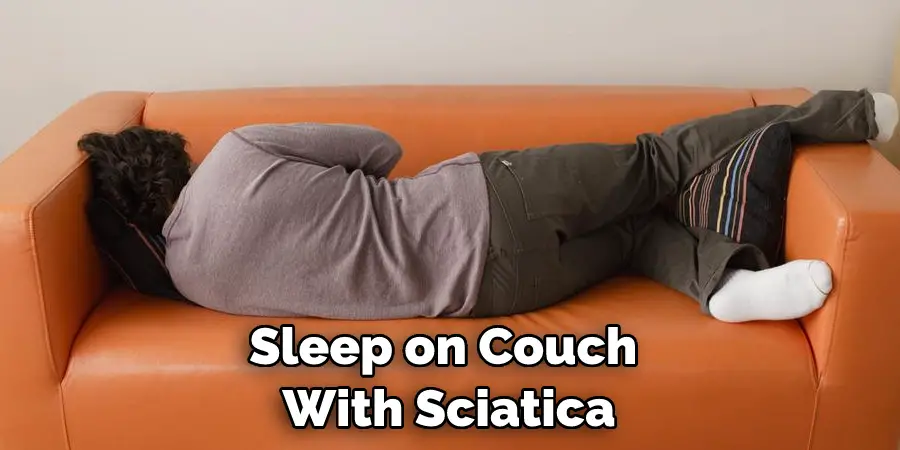Believe it or not, there is a right and wrong way to sit on the couch when you have sciatica. Sitting in the wrong position can aggravate your symptoms and worsen your pain.

However, sit in the right position, and you’ll be more comfortable and may even find some relief from your sciatica pain. So how do you sit on the couch correctly with sciatica? Read on for tips on how to sit on couch with sciatica.
What Is Sciatica?
Sciatica is a medical condition characterized by pain going down the leg from the lower back. This condition is caused by irritation of the sciatic nerve, the longest nerve in the body. The sciatic nerve starts in the lower back and runs through the buttocks and down the back of the legs.
When this nerve is irritated, it can cause pain, numbness, or weakness in the legs. Sciatica can be caused by several things, including a herniated disc, bone spur, or narrowing of the spinal canal.
Treatment for sciatica usually involves pain relief and physical therapy to strengthen the muscles around the sciatic nerve. In some cases, surgery may be necessary to relieve pressure on the nerve.
How to Sit on Couch with Sciatica: 6 Tips
1. Invest In the Right Chair
If you’re going to be sitting for extended periods, it’s important to have a comfortable, supportive chair. Look for a chair that allows you to adjust the height and depth of the seat, as well as the backrest.

2. Use a Pillow
Placing a pillow behind your lower back can help to support your spine. This will help to take pressure off of your sciatic nerve. You may need to experiment with different pillow sizes and positions to find what works best for you.
3. Use a Lumbar Roll
If you spend a lot of time sitting, put a lumbar roll in the small of your back to maintain the natural curve of your spine. A lumbar roll is simply a small, cylindrical pillow that you can place at the base of your spine. Sitting on a lumbar roll will help you avoid slouching and maintain good posture.
4. Avoid Crossing Your Legs
Crossing your legs can put pressure on your sciatic nerve. Try to avoid crossing your legs when sitting on the couch. You can also put a pillow between your legs to take the pressure off of your sciatic nerve.
5. Get Up and Move Around
Sitting in the same position for too long can worsen your symptoms, so it’s important to get up and move around every few hours. Take a quick walk around the block or do some gentle stretching to keep your muscles loose.
6. Take Frequent Breaks
When you’re sitting for long periods of time, it’s important to take frequent breaks. Get up and walk around for a few minutes every hour or so. This will help keep your muscles from getting too tense and help prevent stiffness and pain.
That’s it! You’ve now learned how to sit on couch with sciatica. By following these simple tips, you can help to ease your symptoms and prevent further pain.
The Best Way to Sit on A Couch with Sciatica
When it comes to finding the best way to sit on a couch with sciatica, there are a few things you need to keep in mind. First of all, you want to make sure that you’re not putting any additional pressure on your sciatic nerve. This means sitting up straight and avoiding positions that might pinch or compress the nerve.
Additionally, you’ll want to take advantage of any cushions or pillows you can find to help support your back and keep your spine in alignment. And finally, it’s important to listen to your body and avoid any position that causes pain or discomfort.

By following these simple tips, you can help reduce your symptoms and find a comfortable position for you.
What Are Some Tips for Sitting on The Couch with Sciatica?
Sciatica is a condition that can cause pain in the lower back, buttocks, and legs. The pain is caused by pressure on the sciatic nerve, which runs from the lower back to the feet. Sitting on the couch can be difficult for people with sciatica because they may need to put their legs up to relieve pressure on the sciatic nerve.
Here Are Some Tips for Sitting on the Couch With Sciatica
1. Sit on a firm surface:
A firm surface will support your back and help reduce pressure on the sciatic nerve.
2. Place a pillow behind your back:
This will help keep your spine in alignment and reduce pressure on the sciatic nerve.
3. Avoid crossing your legs:
Crossing your legs can increase pressure on the sciatic nerve and worsen the pain.
4. Use a lumbar support cushion:
A lumbar support cushion can help to reduce pressure on the lower back and ease the pain.
5. Get Up and Move Around Every 30 Minutes:
Movement can help to increase blood flow to the area and reduce pain.
Sitting on the couch doesn’t have to be painful if you have sciatica.
How to Make Sitting on The Couch More Comfortable with Sciatica?
Sitting on the couch can be a real pain for those of us who suffer from sciatica. The good news is that you can do a few things to make it more comfortable. First, try sitting on a pillow or cushioned surface. This will help to take some of the pressure off of your sciatic nerve.
Second, try elevating your legs. This can help to reduce inflammation and ease the pain. Finally, make sure to stay well-hydrated. Drinking plenty of fluids helps to keep your muscles and nerves healthy and can reduce discomfort.

By following these simple tips, you can make sitting on the couch much more comfortable – even with sciatica. Keep reading for more information about how to sit on couch with sciatica.
How to Sleep on Couch with Sciatica?
Sciatic nerve pain can make even the simplest activities extremely uncomfortable, like sitting or sleeping. So if you’re dealing with sciatic pain, you may be wondering how to sleep on a couch in a way that minimizes your discomfort. The good news is that there are a few ways to adjust your sleeping position to get some rest despite your sciatica.
One option is to place a pillow under your knees when you sleep on your back. This will help to relieve pressure on your lower back and take some of the strain off of your sciatic nerve. If you’re more comfortable sleeping on your side, try placing a pillow between your knees.
This will again help reduce pressure on your lower back and ease sciatic nerve pain. Whatever position you choose, be sure to use pillows to support your neck and head so that your spine remains in alignment.
With a little bit of trial and error, you should be able to find a position that helps you get some much-needed rest despite your sciatica.
How to Get up From a Couch with Sciatica?
One of the worst things about sciatica is that it can make even the simplest movements incredibly painful. For example, just getting up from a couch can be a challenge, and if you’re not careful, you could make your pain even worse. But with a little bit of planning and some careful execution, getting up from a couch doesn’t have to be a nightmare.
Here’s What You Need to Do
First, put on your shoes. This may seem like an odd place to start, but trust us, it will make a big difference. Wearing shoes with good arch support will take some of the pressure off of your sciatic nerve, and it will also help stabilize your feet and legs.
Next, brace yourself with your hands. Place them on either side of you on the couch, and slowly push yourself up. Try to keep your back as straight as possible as you do this. Leaning forward or slouching will only make your pain worse.
Finally, once you’re upright, take a few slow steps forward. This will help stretch out your sciatic nerve and reduce the inflammation causing your pain. Just be sure to move carefully and avoid sudden jerks or jolts.

If you follow these steps, you should be able to get up from a couch without making your sciatica pain worse. Remember, it’s important to move slowly and carefully to avoid aggravating your condition. And if you need further help, don’t hesitate to ask a friend or family member for assistance.
Frequently Asked Question
Can Sit on Couch Cause Sciatica?
There is no definitive answer to this question. Sitting on a couch can cause sciatica in some people, while it may not be a problem for others. Factors that can contribute to whether or not sitting on a couch will cause sciatica include the individual’s body weight, how often they sit, and the type of couch they are sitting on.
If you are concerned about how sitting on a couch may affect your sciatica, it is best to speak with a healthcare professional for guidance.
Is It Ok to Sit in A Recliner with Sciatica?
Yes, you can sit in a recliner with sciatica. Many people find it more comfortable to sit in a recliner than on a couch. Just be sure to adjust the recliner to sit in a comfortable position. You may also want to use a pillow or cushion to support your back.
Conclusion
Sitting on the couch with sciatica can be a daunting experience, but you can make the process a little bit easier by following these tips. First, take it slow and steady and consult your doctor if the pain doesn’t disappear.
We hope that our tips have helped you feel more prepared for sitting on the couch with sciatica. Thanks for reading our post about how to sit on couch with sciatica.

